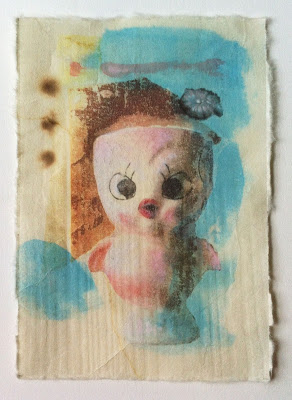With so many Kitsch figurines piling up in my studio, it only seemed natural to pile them up literally. Since totems were meant to signify one's clan or identity, I decided to look at the various ingredients that make up my own identity recipe.
 |
| Tim Laurin, Bannock Totem, Found Objects, 40 in by 30 in approx, 2013 |
This totem is a reaction to my love/hate relationship with food. "Bannock" is a first nation's unleavened bread that is a simply dough of crushed grains and water, rolled onto a twig and cooked over an open fire. It is a favourite demonstration that is overused every time there is a "special event" where first nations' traditions are highlighted. Growing up as a child of the sixties, baked goods were often substituted for love - hence my strange relationship with food is explained. The tiny bird trapped in the martini shaker "cage" is visually accessible, yet suffocating. The teapot shaped sugar bowl of a beautiful young lady is reminiscent of my Memere, a stern woman who we would often visit for tea and yes, baked goods. The sugar bowl was in shards so like an archeologist, I reassembled her with the use of beeswax. I believe memories are torn apart and reassembled often. Both the pink bird and the sugar bowl nestle on rabbit fur - warm, soft and cuddly (you guessed it, just like baked goods). The brittle plastic matriarch resides on top of the totem - like my own mother, present yet tenuous.
 |
| Tim Laurin, Father Totem, Found Objects, 60 in by 14 in approx, 2013 |
Father Totem is the companion piece to Bannock Totem. Utilizing the other half of the plastic figure set, I placed the Indian Chief on top of a copper and brass horn. As a youngster, I remember my father shouting out absolute truths. The antler is the obvious symbol of virility and the hand which originally was positioned upward, was to remind me of his stubborn rule. While assembling the work, I turned the hand downward for some reason and now I realize that this is much more appropriate as my father is currently suffering from dementia and the once mighty patriarch is now but a frail man. The whole assemblage rests on ruffled lead, cast concrete and a scorched timber plinth. This was meant to give the work a sense of stability and power that I view as a veneer of masculinity.










